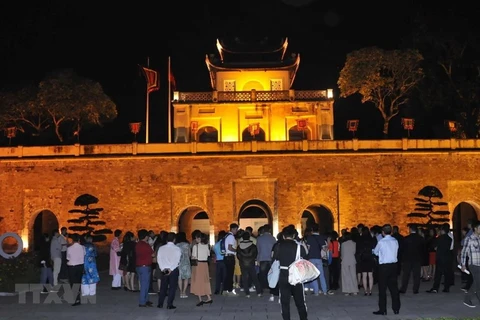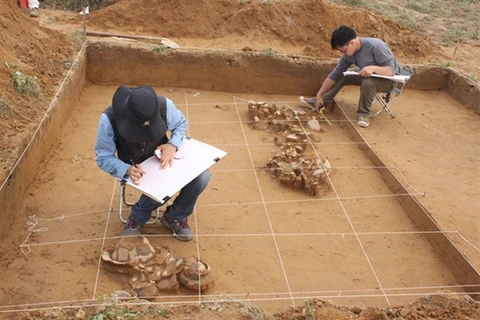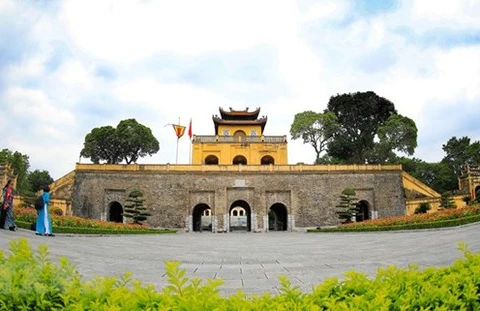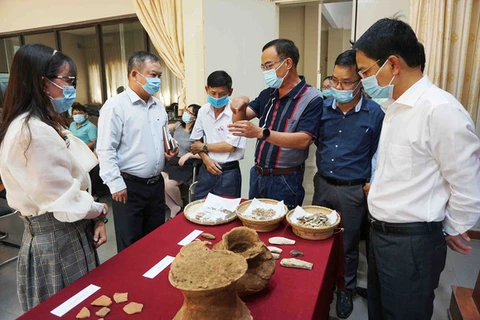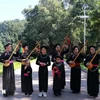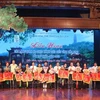Yen Bai (VNA) – Archaeologists have discovered findings with cultural values of the prehistoric period in Vietnam through an urgent archaeological excavation of Tuan Quan relic site in northern Yen Bai province, which confirms that the site is a particularly rare and precious relic belonging to the late Stone Age and feudal periods.
The Tuan Quan archaeological site is located in Yen Ninh ward in Yen Bai city with two smaller sites of Tuan Quan No. 1 and No. 2.
It was discovered in 2001. The Tuan Quan No.1 relic site was surveyed in 2018 and excavated for the first time in 2019, while the Tuan Quan No. 2 site has been explored since 2002.
During the digging at the Tuan Quan No.1 site, archaeologists discovered a large number of stone tools of different kinds and shapes, which helped them confirm that the site was built about 11,000 years ago during the Hoa Binh culture. A small number of prehistoric ceramic pieces as well as Vietnamese and Chinese pottery pieces were also found at the site, along with bronze coins belonging to the Nguyen Dynasty. The pottery pieces are thought to date back to Dong Dau - Go Mun cultures.
At the Tuan Quan No. 2 site, archaeologists discovered a number of pieces of tiles, bricks, pottery, and glazed terra-cotta dating back to the Le and Nguyen Dynasties (17th - 18th centuries). They also found two relatively complete kilns at a depth of 1.4m.
Ly Kim Khoa, Vice Director of Yen Bai Museum who directs the excavation of the Tuan Quan No. 2 site, said that the kilns are like those made in late Le Dynasty or early Nguyen Dynasty (17th - 18th centuries).
Meanwhile, Dr Pham Thanh Son from the Institute of Archaeology, held that the Tuan Quan No. 1 site may date back to 10,000 -15,000 years ago, with high archaeological values.
An archaeological report in early July 2021 also confirmed that Tuan Quan is an extremely precious relic site in the system of prehistoric archaeological sites in Vietnam, which plays a very important role in the exploration of the origin of Son Vi- Hoa Binh Culture in Vietnam and Southeast Asia./.
The Tuan Quan archaeological site is located in Yen Ninh ward in Yen Bai city with two smaller sites of Tuan Quan No. 1 and No. 2.
It was discovered in 2001. The Tuan Quan No.1 relic site was surveyed in 2018 and excavated for the first time in 2019, while the Tuan Quan No. 2 site has been explored since 2002.
During the digging at the Tuan Quan No.1 site, archaeologists discovered a large number of stone tools of different kinds and shapes, which helped them confirm that the site was built about 11,000 years ago during the Hoa Binh culture. A small number of prehistoric ceramic pieces as well as Vietnamese and Chinese pottery pieces were also found at the site, along with bronze coins belonging to the Nguyen Dynasty. The pottery pieces are thought to date back to Dong Dau - Go Mun cultures.
At the Tuan Quan No. 2 site, archaeologists discovered a number of pieces of tiles, bricks, pottery, and glazed terra-cotta dating back to the Le and Nguyen Dynasties (17th - 18th centuries). They also found two relatively complete kilns at a depth of 1.4m.
Ly Kim Khoa, Vice Director of Yen Bai Museum who directs the excavation of the Tuan Quan No. 2 site, said that the kilns are like those made in late Le Dynasty or early Nguyen Dynasty (17th - 18th centuries).
Meanwhile, Dr Pham Thanh Son from the Institute of Archaeology, held that the Tuan Quan No. 1 site may date back to 10,000 -15,000 years ago, with high archaeological values.
An archaeological report in early July 2021 also confirmed that Tuan Quan is an extremely precious relic site in the system of prehistoric archaeological sites in Vietnam, which plays a very important role in the exploration of the origin of Son Vi- Hoa Binh Culture in Vietnam and Southeast Asia./.
VNA

